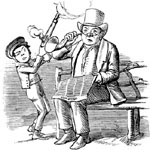
Transitioning Back to Sanity
IDEOLOGY, POLITICS, & MONEY
Ed. Note: This column involves a subject that is graphic in nature and may be upsetting to some. Readers are duly warned.
As soon as he returned to the Oval Office this January, Donald Trump unleashed a flurry of executive orders. He signed a whopping 37 in the first week of his second term — a historic clip. Some were righteous (e.g., restoring the Hyde Amendment, which prevents federal funding or promotion of abortion), others ridiculous (e.g., renaming the Gulf of Mexico to the Gulf of America). Among the former, one executive order is particularly worthy of our attention. Titled “Protecting Children from Chemical and Surgical Mutilation” (henceforth PCCSM), it addresses what I’ve termed transanity (see my column “Transanity Is Taking Over. How Will the Church Respond?” Jan.-Feb. 2024), or the rapid — and reckless — rise of gender ideology.
Gender ideologists believe that gender (male or female) is “assigned at birth” by parents, a doctor, or both, and that a person can “transition” from one gender to another with the aid of hormone therapy and surgeries. These ideologues command a multifaceted and massively successful movement, one that has altered the contours of education, entertainment, language, athletics, politics, and medicine. And it’s a money machine. As of 2022, the U.S. sex-reassignment-surgery market size was estimated at $2.1 billion, with an expected compound annual growth rate of 11.25 percent. Pharmaceutical giants, healthcare providers, insurance companies — they all stand to profit from the proliferation of what’s euphemistically labeled gender-affirming care.
One of the fastest areas of growth in this movement is so-called gender-affirming care for minors (henceforth GACM). A decade ago, there were only a handful of gender clinics for children in North America; as of today, there are over 400. In these clinics, and in hospitals across the nation (including nearly 150 Catholic hospitals), medical professionals have been “maiming and sterilizing a growing number of impressionable children under the radical and false claim that adults can change a child’s sex through a series of irreversible medical interventions,” PCCSM states. When an adult pushes a child down the path of transition, that child will need gender-related therapies for the rest of his life. Studies show that well over 90 percent of children who start puberty blockers (the long-term effects of which are still unknown) progress to cross-sex hormones. Some then advance to radical surgeries that often have serious complications and require — you guessed it — more medical interventions. Each child who suffers from gender dysphoria (or what was known as gender-identity disorder until the ideologues made inroads into the American Psychiatric Association just over a decade ago) is a potential cash cow.
In declaring that henceforth it is “the policy of the United States that it will not fund, sponsor, promote, assist, or support the so-called ‘transition’ of a child from one sex to another, and it will rigorously enforce all laws that prohibit or limit these destructive and life-altering procedures,” PCCSM threatens to cut off a major source of income for powerful — and powerfully greedy — groups. PCCSM instructs all institutions receiving federal grants to desist from performing “chemical and surgical mutilation of children,” and all federal insurance policies to remove such procedures from coverage.
You May Also Enjoy
A Protestant need not fret about a clash between religion and culture; for him, the two have generally been inseparable.
The intentionally effeminate metrosexual is another fruit of the postmodern sexual assault, specifically the assault on masculine integrity.
Radcliffe is a walking cliché who parrots all the standard liberal dogmas like women’s ordination, gays in the priesthood, and Communion for remarried Catholics.

